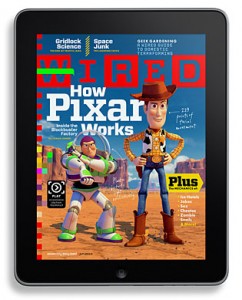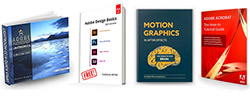Back at the TED Conference in February, Adobe unveiled a prototype of a new digital magazine solution running on a tablet computer… The demo was built on the cross-platform (and Flash-based) Adobe AIR environment and illustrated the possibilities for magazine publishers to reach readers in new ways. The concept enabled — in digital form — the immersive content experience magazines are known for, and allowed new interactive features to stimulate reader engagement. The idea was that with the upcoming release of Creative Suite 5, publishers could use the new InDesign CS5 to create the rich media content for the new format, and then run the reader applications across a variety of device types because Adobe AIR is portable – including the iPhone and iPad through the new Packager for iPhone capability included in Flash Professional CS5…
But then in early April, just before CS5 was launched, Apple made some changes to their SDK license restricting the technologies that developers can use for their products, including Adobe Flash software… So without Flash-derived apps being approved in Apple’s App Store, would that mean the end of Adobe’s new magazine publishing initiative on Apple devices?
On the contrary actually – showing remarkable speed and resourcefulness, Adobe yesterday announced the official release of the first magazine (WIRED) and Reader application using the new format, available now through the Apple iTunes App Store:
Created with InDesign® CS5 and additional Adobe® publishing technologies, the WIRED Reader is designed to revolutionize the magazine reading experience and allows readers to immerse themselves in magazine content like never before. This Digital Publishing Solution showcases how Adobe is enabling magazine and other publishers to deliver groundbreaking experiences across tablets, smartphones and other devices. Soon, the company plans to deliver software on Adobe Labs that will help publishers to transform InDesign CS5 layouts into compelling applications like WIRED Reader. Because this digital magazine solution integrates tightly with Creative Suite® 5, publishers can expect to leverage their existing workflow investments and designer skills.
So how did they do it?
The answer is revealed by putting together the pieces from a new FAQ on Adobe’s site – in just two months Adobe reimplemented their Digital Publishing Platform to use Objective-C to support the iPad, and will continue to use Adobe AIR and Flash everywhere else:
Adobe is pursuing a multiplatform development strategy that will include Objective-C for the iPad and the Adobe AIR® runtime for the desktop and other mobile platforms. Adobe AIR is a cross–platform solution for building applications based on Adobe Flash technology. AIR 2 and Flash Player 10.1 software will deliver high performance on mobile screens and allow publishers to create engaging, standout experiences for a wide variety of devices (Android™, Windows, Linux), as well as leverage the industry-standard advertising platform built with Flash technologies.
So there you have it – showing there’s more than one way to skin a cat, and a victory for both companies really… Also exciting is the release of the new portable publishing technology this summer on the (free) Adobe Labs – software which, “in combination with InDesign CS5, will equip you to begin developing your digital publishing workflows and creating a solution similar to the WIRED Reader experience.”
[UPDATE (July 19th) – Late this summer, Adobe will release these new publishing technologies (Digital Content Bundler and Digital Content Viewer) on Adobe Labs… Publishers can add interactivity without writing code using InDesign CS5 and create monetizable digital magazines for the Apple iPad – with other platforms and devices expected in the future.]







I believe Adobe will use a generated meta-language output from InDesign or Flash and compile it in either objective-C for the iPad/iPhone or SWF/Air for the web/Android.
That way they fully comply to the Apple SDK as they will natively compile in objective-C and still be cross-platform.
Fantastic work by Adobe. Thanks for the article.